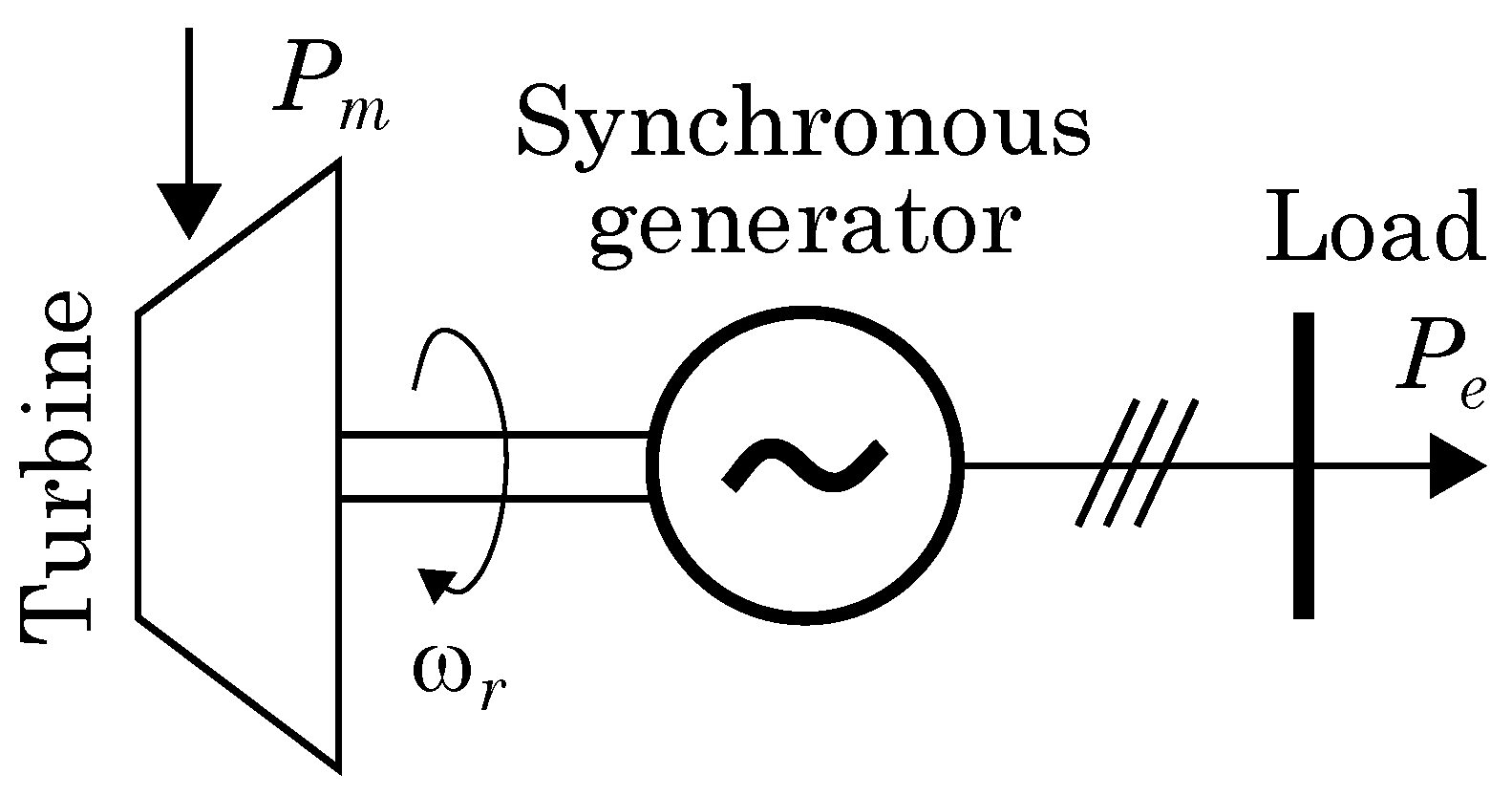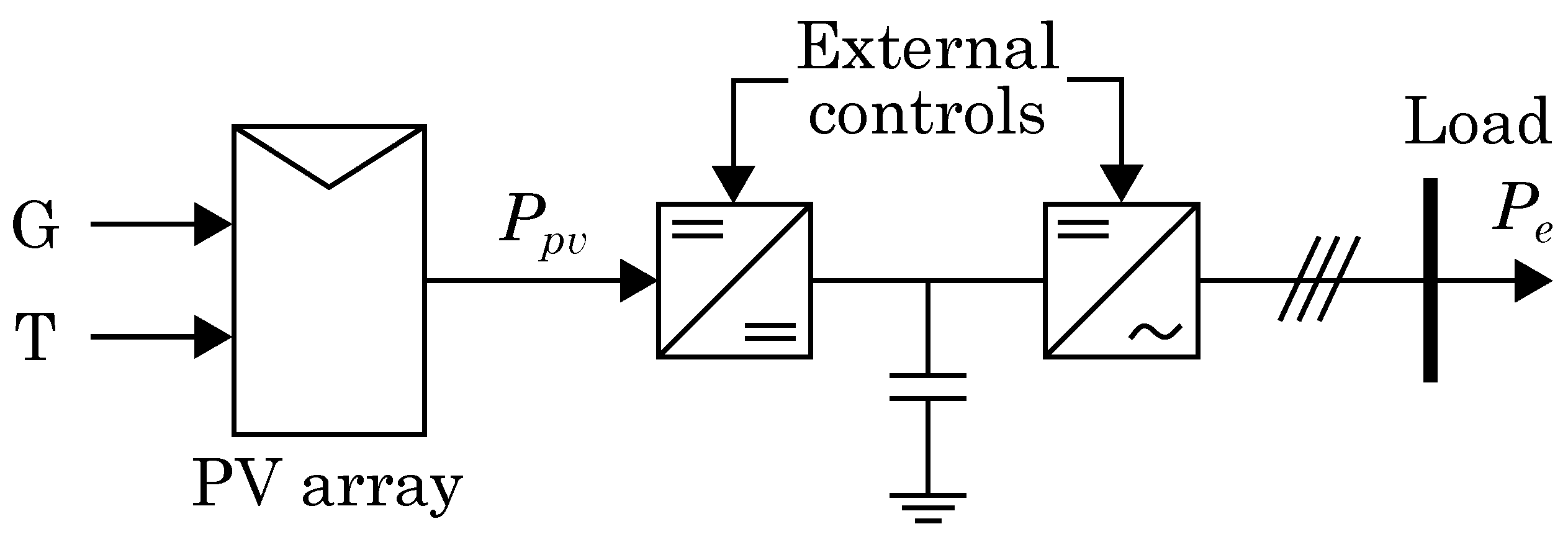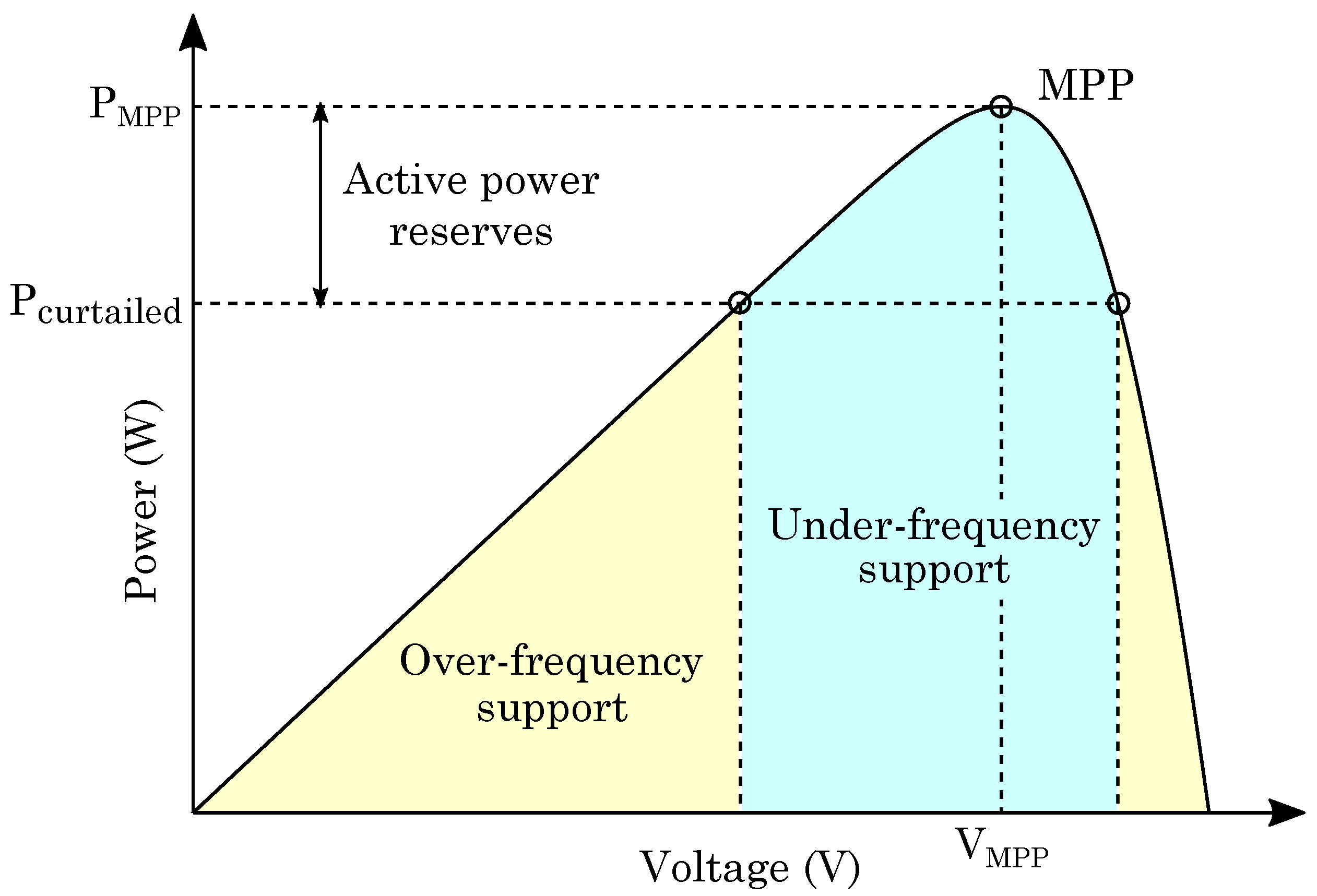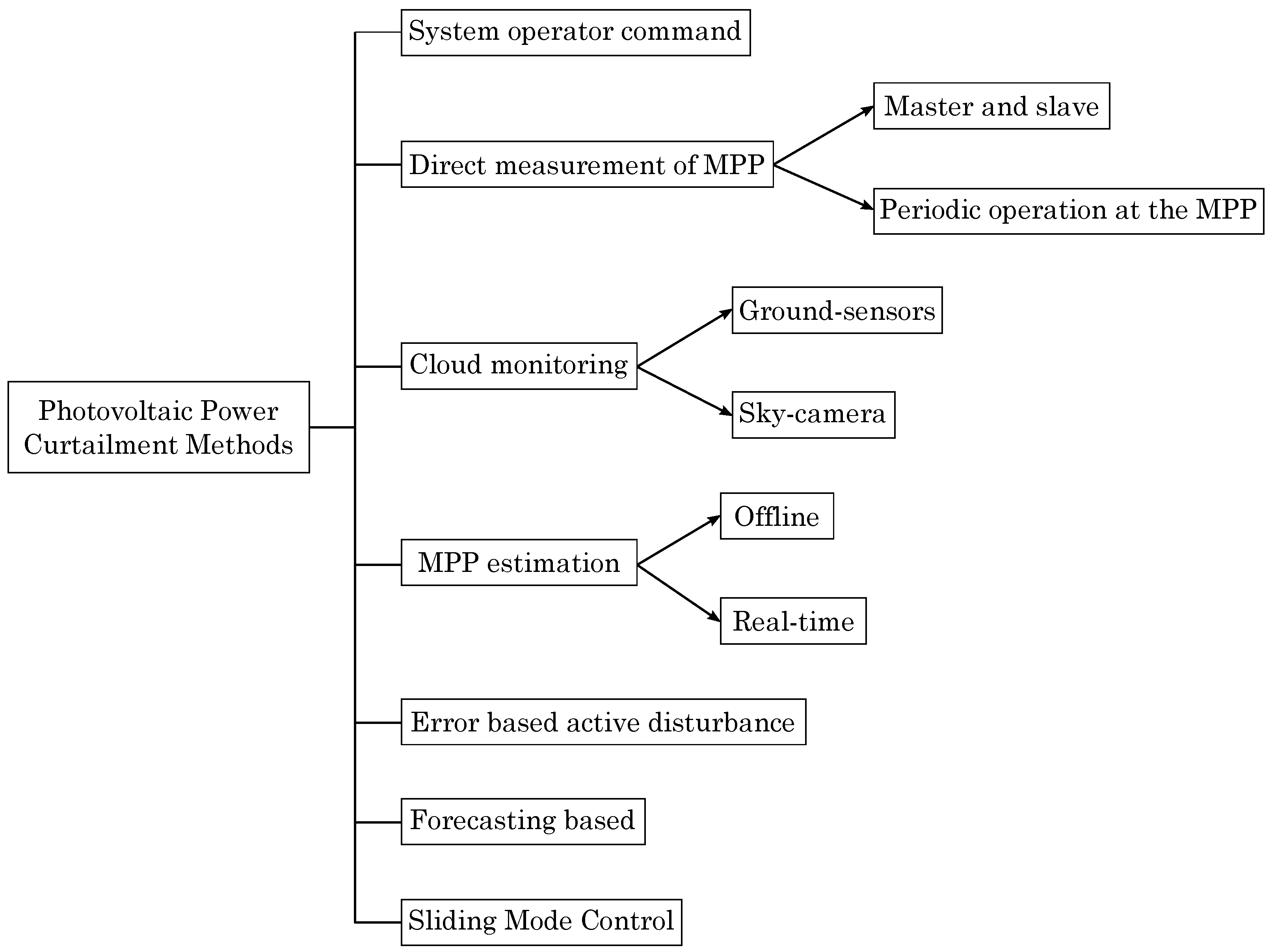New Trends in the Control of Grid-Connected Photovoltaic Systems for the Provision of Ancillary Services
Abstract
:1. Introduction
- 1.
- How different methods determine the maximum available power while operating below that point’
- 2.
- Implementation details, such as additional equipment required or the most appropriate plant size for one type of control’
- 3.
- The application the control is designed for. For example constant power generation, power reserves control, power ramp-rate control, or virtual inertia control.
2. Traditional Control of Grid-Connected Photovoltaic Systems
3. Alternative Control of Grid-Connected Photovoltaic Systems
3.1. Methods Based on a System Operator Command
3.2. Methods Based on Direct Measurement of the MPP
3.3. Methods Based on Cloud Monitoring
3.4. Methods Based on Maximum Power Point Estimation
3.5. Methods Based on Error-Based Active Disturbance
3.6. Methods Based on Forecasting
3.7. Methods Based on Sliding Mode Control
4. Recommendations of the Authors
5. Conclusions
Author Contributions
Funding
Data Availability Statement
Conflicts of Interest
Abbreviations
| APPT | adaptive power point tracking |
| CPG | constant power generation |
| FPPT | flexible power point tracking |
| GBSFS | ground-based sensor forecasting system |
| GMPPT | global maximum power point tracking |
| MPP | maximum power point |
| MPPT | maximum power point tracking |
| P&O | perturb and observe |
| PFR | primary frequency regulation |
| PRC | power reserve control |
| PRRC | power ramp-rate control |
| PV | photovoltaic |
| SMC | sliding mode control |
| SO | system operator |
| VIC | virtual inertia control |
References
- Zou, C.; Zhao, Q.; Zhang, G.; Xiong, B. Energy revolution: From a fossil energy era to a new energy era. Nat. Gas Ind. B 2016, 3, 1–11. [Google Scholar] [CrossRef] [Green Version]
- Hardisty, P.E.; Clark, T.S.; Hynes, R.G. Life Cycle Greenhouse Gas Emissions from Electricity Generation: A Comparative Analysis of Australian Energy Sources. Energies 2012, 5, 872–897. [Google Scholar] [CrossRef] [Green Version]
- Tajeddin, A.; Roohi, E. Designing a reliable wind farm through hybridization with biomass energy. Appl. Therm. Eng. 2019, 154, 171–179. [Google Scholar] [CrossRef]
- IEA. Installed Capacity in the European Union, 2000–2010, and Projections up to 2040 in the Sustainable Development Scenario; Technical Report; International Energy Agency: Paris, France, 2020. [Google Scholar]
- Mohandes, B.; Moursi, M.S.E.; Hatziargyriou, N.; Khatib, S.E. A Review of Power System Flexibility with High Penetration of Renewables. IEEE Trans. Power Syst. 2019, 34, 3140–3155. [Google Scholar] [CrossRef]
- Fang, J.; Li, H.; Tang, Y.; Blaabjerg, F. On the Inertia of Future More-Electronics Power Systems. IEEE J. Emerg. Sel. Top. Power Electron. 2019, 7, 2130–2146. [Google Scholar] [CrossRef]
- Kundur, P.; Balu, N. Power System Stability and Control, 1st ed.; McGraw-Hill: New York, NY, USA, 1994. [Google Scholar]
- Sigrist, L.; Egido, I.; Lobato Miguélez, E.; Rouco, L. Sizing and Controller Setting of Ultracapacitors for Frequency Stability Enhancement of Small Isolated Power Systems. IEEE Trans. Power Syst. 2015, 30, 2130–2138. [Google Scholar] [CrossRef]
- Nguyen, N.; Mitra, J. Effect of wind power on load frequency control. In Proceedings of the 2016 IEEE Power and Energy Society General Meeting (PESGM), Boston, MA, USA, 17–21 July 2016; pp. 1–5. [Google Scholar] [CrossRef]
- Batzelis, E.I.; Anagnostou, G.; Cole, I.R.; Betts, T.R.; Pal, B.C. A State-Space Dynamic Model for Photovoltaic Systems with Full Ancillary Services Support. IEEE Trans. Sustain. Energy 2019, 10, 1399–1409. [Google Scholar] [CrossRef] [Green Version]
- Van de Vyver, J.; De Kooning, J.D.M.; Meersman, B.; Vandevelde, L.; Vandoorn, T.L. Droop Control as an Alternative Inertial Response Strategy for the Synthetic Inertia on Wind Turbines. IEEE Trans. Power Syst. 2016, 31, 1129–1138. [Google Scholar] [CrossRef]
- Crăciun, B.I.; Kerekes, T.; Séra, D.; Teodorescu, R. Frequency Support Functions in Large PV Power Plants with Active Power Reserves. IEEE J. Emerg. Sel. Top. Power Electron. 2014, 2, 849–858. [Google Scholar] [CrossRef]
- Li, Q.; Baran, M.E. A Novel Frequency Support Control Method for PV Plants Using Tracking LQR. IEEE Trans. Sustain. Energy 2020, 11, 2263–2273. [Google Scholar] [CrossRef]
- Zhong, C.; Zhou, Y.; Yan, G. A Novel Frequency Regulation Strategy for a PV System Based on the Curtailment Power-Current Curve Tracking Algorithm. IEEE Access 2020, 8, 77701–77715. [Google Scholar] [CrossRef]
- Sukumar, S.; Marsadek, M.; Agileswari, K.R.; Mokhlis, H. Ramp-rate control smoothing methods to control output power fluctuations from solar photovoltaic (PV) sources—A review. J. Energy Storage 2018, 20, 218–229. [Google Scholar] [CrossRef]
- Martins, J.; Spataru, S.; Sera, D.; Stroe, D.I.; Lashab, A. Comparative study of ramp-rate control algorithms for PV with energy storage systems. Energies 2019, 12, 1342. [Google Scholar] [CrossRef] [Green Version]
- Solomon, A.; Bogdanov, D.; Breyer, C. Curtailment-storage-penetration nexus in the energy transition. Appl. Energy 2019, 235, 1351–1368. [Google Scholar] [CrossRef]
- Li, X.; Wang, Q.; Wen, H.; Xiao, W. Comprehensive Studies on Operational Principles for Maximum Power Point Tracking in Photovoltaic Systems. IEEE Access 2019, 7, 121407–121420. [Google Scholar] [CrossRef]
- Cormode, D.; Cronin, A.D.; Richardson, W.; Lorenzo, A.T.; Brooks, A.E.; DellaGiustina, D.N. Comparing ramp rates from large and small PV systems, and selection of batteries for ramp rate control. In Proceedings of the 2013 IEEE 39th Photovoltaic Specialists Conference (PVSC), Tampa, FL, USA, 16–21 June 2013; pp. 1805–1810. [Google Scholar] [CrossRef]
- Li, X.; Wen, H.; Chen, B.; Ding, S.; Xiao, W. A cost-effective power ramp rate control strategy based on flexible power point tracking for photovoltaic system. Sol. Energy 2020, 208, 1058–1067. [Google Scholar] [CrossRef]
- Khan, A.; D’silva, S.; Fard, A.Y.; Shadmand, M.B.; Abu-Rub, H. On Stability of PV Clusters with Distributed Power Reserve Capability. IEEE Trans. Ind. Electron. 2021, 68, 3928–3938. [Google Scholar] [CrossRef]
- Sangwongwanich, A.; Yang, Y.; Blaabjerg, F.; Sera, D. Delta Power Control Strategy for Multistring Grid-Connected PV Inverters. IEEE Trans. Ind. Appl. 2017, 53, 3862–3870. [Google Scholar] [CrossRef]
- Peng, Q.; Tang, Z.; Yang, Y.; Liu, T.; Blaabjerg, F. Event-Triggering Virtual Inertia Control of PV Systems with Power Reserve. IEEE Trans. Ind. Appl. 2021, 57, 4059–4070. [Google Scholar] [CrossRef]
- Tafti, H.D.; Wang, Q.; Townsend, C.D.; Pou, J.; Konstantinou, G. Global Flexible Power Point Tracking in Photovoltaic Systems Under Partial Shading Conditions. IEEE Trans. Power Electron. 2022, 37, 11332–11341. [Google Scholar] [CrossRef]
- Chen, X.; Du, Y.; Wen, H.; Jiang, L.; Xiao, W. Forecasting-Based Power Ramp-Rate Control Strategies for Utility-Scale PV Systems. IEEE Trans. Ind. Electron. 2019, 66, 1862–1871. [Google Scholar] [CrossRef]
- Saleh, M.; Meek, L.; Masoum, M.A.S.; Abshar, M. Battery-Less Short-Term Smoothing of Photovoltaic Generation Using Sky Camera. IEEE Trans. Ind. Inform. 2018, 14, 403–414. [Google Scholar] [CrossRef]
- Hoke, A.F.; Shirazi, M.; Chakraborty, S.; Muljadi, E.; Maksimovic, D. Rapid Active Power Control of Photovoltaic Systems for Grid Frequency Support. IEEE J. Emerg. Sel. Top. Power Electron. 2017, 5, 1154–1163. [Google Scholar] [CrossRef]
- Batzelis, E.I.; Kampitsis, G.E.; Papathanassiou, S.A. Power Reserves Control for PV Systems with Real-Time MPP Estimation via Curve Fitting. IEEE Trans. Sustain. Energy 2017, 8, 1269–1280. [Google Scholar] [CrossRef]
- Li, X.; Wen, H.; Zhu, Y.; Jiang, L.; Hu, Y.; Xiao, W. A Novel Sensorless Photovoltaic Power Reserve Control with Simple Real-Time MPP Estimation. IEEE Trans. Power Electron. 2019, 34, 7521–7531. [Google Scholar] [CrossRef]
- Riquelme-Dominguez, J.M.; Martinez, S. A Photovoltaic Power Curtailment Method for Operation on Both Sides of the Power-Voltage Curve. Energies 2020, 13, 3906. [Google Scholar] [CrossRef]
- Ye, D.; Riquelme-Dominguez, J.M.; Martinez, S. Estimation of the Output Characteristic of a Photovoltaic Generator under Power Curtailment and Considering Converter Losses. Electronics 2022, 11, 1544. [Google Scholar] [CrossRef]
- Zhong, C.; Zhou, Y.; Yan, G. Power reserve control with real-time iterative estimation for PV system participation in frequency regulation. Int. J. Electr. Power Energy Syst. 2021, 124, 106367. [Google Scholar] [CrossRef]
- Riquelme-Dominguez, J.M.; García-López, F.D.P.; Martinez, S. Power Ramp-Rate Control via power regulation for storageless grid-connected photovoltaic systems. Int. J. Electr. Power Energy Syst. 2022, 138, 107848. [Google Scholar] [CrossRef]
- Hou, G.; Ke, Y.; Huang, C. A flexible constant power generation scheme for photovoltaic system by error-based active disturbance rejection control and perturb & observe. Energy 2021, 237, 121646. [Google Scholar] [CrossRef]
- Chang, J.; Du, Y.; Lim, E.G.; Wen, H.; Li, X.; Jiang, L. Coordinated Frequency Regulation Using Solar Forecasting Based Virtual Inertia Control for Islanded Microgrids. IEEE Trans. Sustain. Energy 2021, 12, 2393–2403. [Google Scholar] [CrossRef]
- Li, Z.; Cheng, Z.; Si, J.; Zhang, S.; Dong, L.; Li, S.; Gao, Y. Adaptive Power Point Tracking Control of PV System for Primary Frequency Regulation of AC Microgrid with High PV Integration. IEEE Trans. Power Syst. 2021, 36, 3129–3141. [Google Scholar] [CrossRef]






| Method | Classification | Operation Side | PV System Size | Additional Equipment | Application |
|---|---|---|---|---|---|
| [20] | System operator command | Left | Large | No | PRRC |
| [21] | System operator command | Right | Large | No | CPG |
| [22] | Direct measurement of MPP | Right | Small, large | Communication systems | CPG |
| [23] | Direct measurement of MPP | Left | Small, large | No | PRC |
| [24] | Direct measurement of GMPP | Left, right | Small, large | No | CPG, PRC |
| [25] | Cloud monitoring | Right | Large | GBSFS | PRRC |
| [26] | Cloud monitoring | Right | Large | Sky camera | PRRC |
| [27] | MPP estimation | Right | Small, large | Irradiance and temperature sensors | PRC |
| [28] | MPP estimation | Right | Small, large | No | PRC |
| [29] | MPP estimation | left | Small, large | No | PRC |
| [30] | MPP estimation | Left, right | Small, large | No | PRC |
| [32] | MPP estimation | Left | Small, large | No | VIC, Droop control |
| [31] | MPP estimation | Left | Small, large | No | PRC |
| [33] | MPP estimation | Right | Small, large | No | PRRC |
| [34] | Error-based active disturbance | Left, right | Small, large | No | CPG |
| [35] | Forecasting-based | Right | Large | No | VIC |
| [36] | Sliding mode control | Left | Small, Large | No | PFR |
Publisher’s Note: MDPI stays neutral with regard to jurisdictional claims in published maps and institutional affiliations. |
© 2022 by the authors. Licensee MDPI, Basel, Switzerland. This article is an open access article distributed under the terms and conditions of the Creative Commons Attribution (CC BY) license (https://creativecommons.org/licenses/by/4.0/).
Share and Cite
Riquelme-Dominguez, J.M.; Riquelme, J.; Martinez, S. New Trends in the Control of Grid-Connected Photovoltaic Systems for the Provision of Ancillary Services. Energies 2022, 15, 7934. https://doi.org/10.3390/en15217934
Riquelme-Dominguez JM, Riquelme J, Martinez S. New Trends in the Control of Grid-Connected Photovoltaic Systems for the Provision of Ancillary Services. Energies. 2022; 15(21):7934. https://doi.org/10.3390/en15217934
Chicago/Turabian StyleRiquelme-Dominguez, Jose Miguel, Jesús Riquelme, and Sergio Martinez. 2022. "New Trends in the Control of Grid-Connected Photovoltaic Systems for the Provision of Ancillary Services" Energies 15, no. 21: 7934. https://doi.org/10.3390/en15217934
APA StyleRiquelme-Dominguez, J. M., Riquelme, J., & Martinez, S. (2022). New Trends in the Control of Grid-Connected Photovoltaic Systems for the Provision of Ancillary Services. Energies, 15(21), 7934. https://doi.org/10.3390/en15217934







